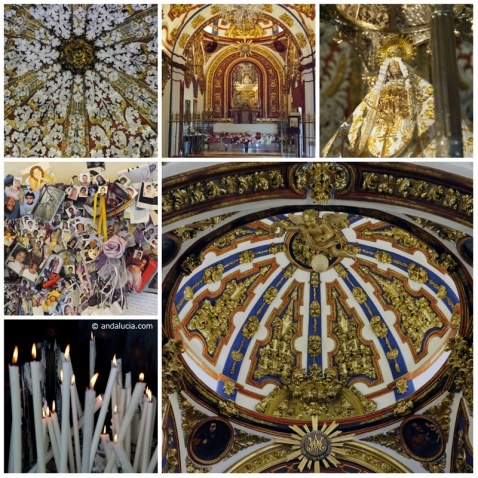
The Hermitage Chruch Nuestra Señora de los Remedios ( click to emlarge photos) © Michelle Chaplow |
|
Cártama- things to see
Ermita de Nuestra Señora de los Remedios
The Ermita de Nuestra Señora de los Remedios - the town's patron saint - is still a focus of reverent pilgrimage for devout locals, and is perched high above Cártama's twisting streets. The shrine is well worth the visit and can be reached by climbing the vertiginous zig-zag path from the main square near the Pilar Alto Fountain. If it is a hot day, take some water along for the climb. Read more>
Fuente de Pilar Alto
The Fuente de Pilar Alto - the word pilar has several meanings, one being 'the base of a fountain'. This stone water fountain is near San Pedro church, standing beneath a protective arched canopy. The fountain is dated 1872 and the canopy 1976. (36.709496, -4.631312)
Iglesia Parroquia de San Pedro Apostol
The Iglesia Parroquia de San Pedro Apostol bears the date 1502, shortly after the Reconquest by the Catholic Kings, and may well be built on the site of a former mosque. The main renaissance-style entrance from the square leads into the side of the church. In typical style, it has three naves, separated by pillars supporting half-point arches clad in wood, mixing Gothic, Mudejar, and Renaissance elements. Less typical is the drinks-style vending machine, which sells votive candles - an unusual modern touch. A small room at the back has walls of niches for cremated remains of worshippers, with silver plaques naming the occupants. During the restoration of 2005, wall paintings dating from 1824 were found on the tower. (36.710012, -4.631628)
Castillo de Cártama
The Castilla de Cártama (Cártama Castle) - a further climb from the shrine leads up to the 10th-century Moorish castle situated above it. This ascent is far more difficult and not for the faint-hearted. You will need to scramble along a steep and narrow path, which begins outside the gates of the shrine, and leads to what was the castle's main keep and bailey. The site is large, and many of the old walls have survived, so it only takes a little imagination to see how impenetrable the double-walled fortress would have been. The first defensive wall had ten towers and the second eight. The castle's capture by the Catholic Monarchs in 1485 is recorded in bas-reliefs in the Coro of Toledo Cathedral. Since then, its main role has been fulfilled, and the castle has gradually decayed. Restoration work was carried out in 2011. (36.70902, -4.62926)
Estación de Cártama
The Estación de Cártama was originally a railway station built in 1863 by the Córdoba to Málaga Railway Company. It is located on the C‑2 Cercanías Málaga line, serving commuter services today. Between 1927 and 1931, the Iron Bridge (Puente de Hierro) was constructed to connect Estación de Cártama with Cártama Pueblo. The bridge was restored in 2001 and re‑illuminated in 2006, typically credited with symbolising the town's connection.
Cruz de Humilladero
The Cruz de Humilladero is named after the forged iron cross attached to the top of a 2nd-century AD marble column - the symbol is incorporated into the town's heraldic crest. The cross was placed at the current site in 1752 to mark the excavation being carried out by the Marqués de Valdeflores.
Ermita de Casapalma
The Ermita de Casapalma was originally built around 1501–1505, roughly contemporaneous with the Church of San Pedro, and served an important local congregation.
Museo de Ntra Sra de los Remedios
The Museo de Ntra Sra de los Remedios was inaugurated in 2007, adjoining the San Pedro church, through you enter. It contains 18th-century photographs and other artefacts of the town, with particular emphasis on religious ones and those connected with the story of the Virgin. These include many velvet cloaks featuring her image donated by grateful parishioners, as well as by the faithful in the US during the Virgin's stay there. The most important item is a blue cloak, embroidered with gold and pearls, which is said to have belonged to the Reyes Catolicos.
Capilla de Sierra Gibralgalia
The Capilla de Sierra Gibralgalia is a lesser-known sanctuary on Sierra Gibralgalia. It has a historical significance, being notable for its origins in the Rural Doctrines, a missionary movement founded by the Blessed Tiburcio Arnaiz and María Isabel González del Valle.
Puente de Hierro
The Puente de Hierro (Iron Bridge) is an iron girder bridge over the Guadalhorce River, built between 1927 and 1931. It is one of the few remaining examples of this type of structure in the province of Málaga. After suffering significant deterioration over the decades, the bridge was restored in 2001, and new lighting was installed in 2006. Today, it is a popular place for locals to stroll, while road traffic uses a new bridge. (36.7295, -4.6135)